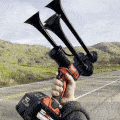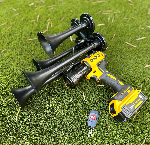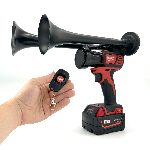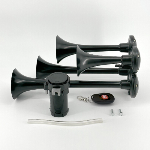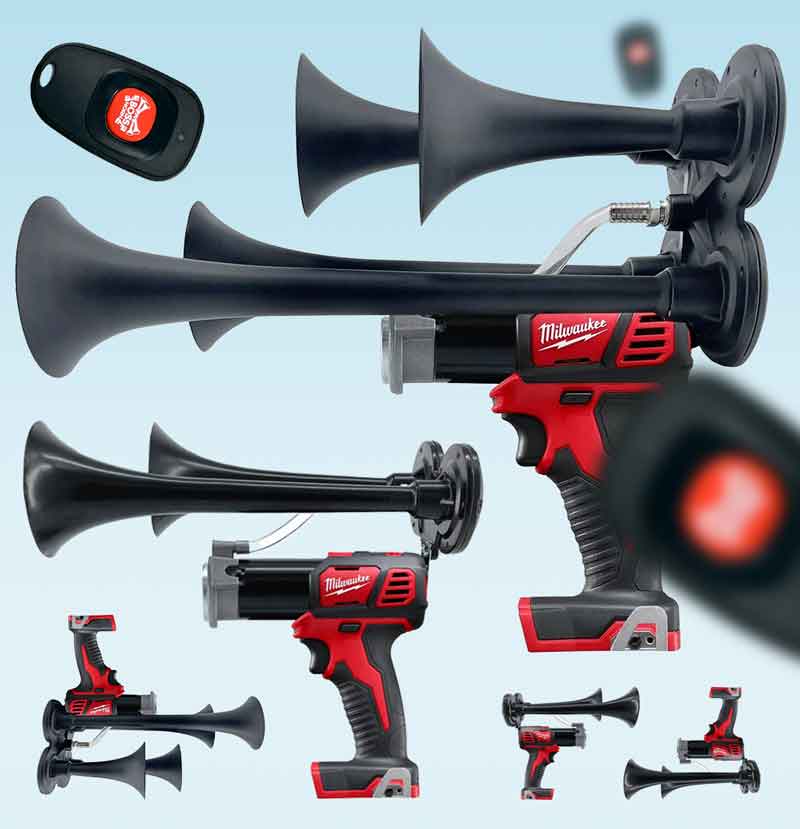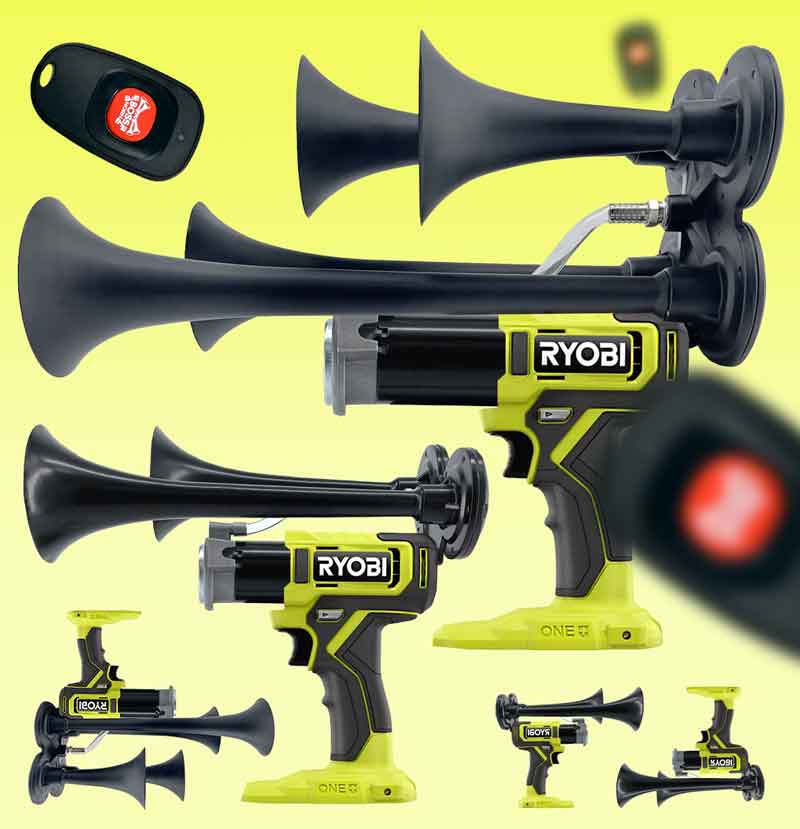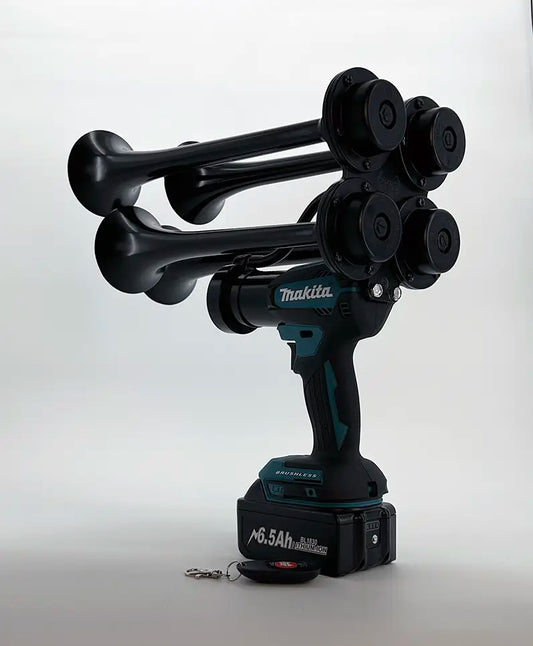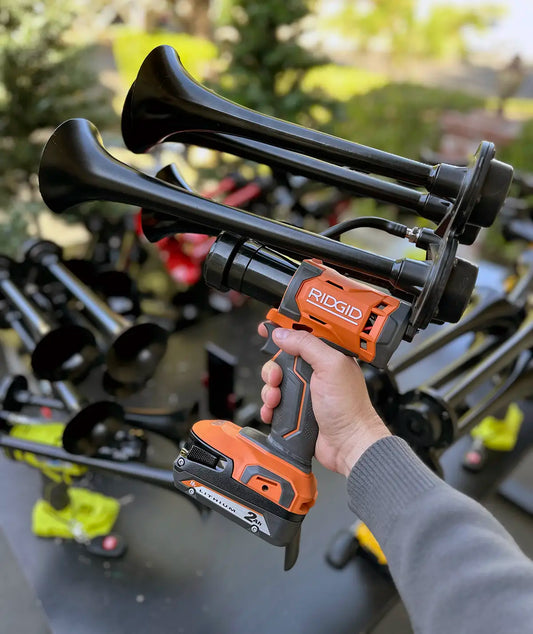Did you know that the average motorcycle weighs around 500 pounds? That's only a fraction of the weight of an average car, making motorcycles nimble and easy to maneuver through traffic. However, due to their small size, motorcycles can be easily overlooked by other drivers on the road, leading to potentially dangerous situations.
To enhance the safety of motorcycle riders, many enthusiasts have been exploring different additions to their motorcycles, one of them being the installation of a train horn. Train horns are extremely loud and can grab the attention of even the most distracted drivers, significantly reducing the risk of accidents.
The concept of putting a train horn on a motorcycle isn't entirely new. In fact, it dates back to the early 1900s when motorcycle enthusiasts began experimenting with different sound devices to increase their visibility on the road. These early inventions were often custom-built and required extensive modifications to the motorcycles.
Fast forward to the present day, and putting a train horn on a motorcycle has become much more accessible and straightforward. With advancements in technology and the availability of aftermarket accessories, motorcycle enthusiasts can now easily install a train horn without the need for complex modifications or extensive DIY skills.
One compelling statistic that highlights the significance of installing a train horn on a motorcycle is that over 40% of motorcycle accidents involve another vehicle violating the motorcycle's right of way. By equipping their motorcycles with a train horn, riders can increase their chances of being noticed and avoid potentially catastrophic accidents.
Thankfully, there are now specialized kits available in the market that make it easier than ever to install a train horn on a motorcycle. These kits come with everything needed for a seamless installation, including the horn itself, a compressor, and all necessary wiring and mounting hardware. Some even offer wireless remote controls, allowing riders to activate the horn with ease.
In conclusion, the installation of a train horn on a motorcycle has evolved from experimental modifications to readily available aftermarket kits. By equipping their motorcycles with a train horn, riders can significantly enhance their safety on the road by capturing the attention of other drivers. With accessible and user-friendly installation options, it's no wonder that many motorcycle enthusiasts are opting to add this valuable addition to their bikes.
Can You Install a Train Horn on a Motorcycle?
Installing a train horn on a motorcycle: Exploring the possibilities and considerations.
Legal Considerations
Before considering putting a train horn on a motorcycle, it is important to understand the legal implications. In most countries, including the United States, there are specific regulations regarding the type and volume of horns allowed on motorcycles. Train horns, known for being extremely loud, may not meet these requirements.
In the U.S., the Federal Motor Vehicle Safety Standards (FMVSS) outline the requirements for horn functionality on vehicles. These standards include guidelines for maximum decibel levels and the specific sound that a horn should produce. Most train horns surpass these limits, making them illegal for use on motorcycles in many jurisdictions.
Technical Challenges
Even if it is legally permissible to install a train horn on a motorcycle, there are technical challenges to consider. Train horns are much larger and heavier than typical motorcycle horns, which can pose space and weight constraints. Mounting a train horn may require modifications to the motorcycle's frame or body, which could impact its aesthetics and stability.
Train horns also require a significant amount of power to operate, usually more than the electrical system of a motorcycle can provide. This means that additional wiring and electrical components may be needed to accommodate the train horn, which can be complex and time-consuming to install.
Safety Concerns
One of the primary reasons train horns are not commonly used on motorcycles is the safety concerns they pose. Train horns are designed to be heard from a considerable distance and are meant to alert motorists and pedestrians of an approaching train. When used on a motorcycle, the extreme volume of a train horn can startle or disorient other drivers, potentially leading to accidents or dangerous situations on the road.
Furthermore, the loudness of train horns may violate noise pollution regulations in certain areas, leading to fines or other penalties.
Statistics on Motorcycle Accidents
- In 2019, motorcycle fatalities accounted for 14% of all motor vehicle crash deaths in the United States.
- Motorcycle accidents are 28 times more likely to result in fatalities compared to accidents involving other vehicles.
- The most common cause of motorcycle accidents is collision with a fixed object, such as a tree or pole.
- Nearly half of all fatal motorcycle crashes involve another motor vehicle.
- Wearing a helmet reduces the risk of death in a motorcycle accident by 37%.
https://youtube.com/watch?v=EMT4DePclSk
Q: Is it legal to install a loud horn on a motorcycle?
A: Understanding the Legal Requirements
Yes, it is legal to install a loud horn on a motorcycle, provided that it adheres to certain legal requirements. These requirements may vary depending on your location, so it is crucial to familiarize yourself with the specific regulations in your area. Generally, motorcycles are required to have a horn that is audible from a certain distance and meets certain decibel limits. It is also important to consider the impact your horn's volume might have on others and to use it responsibly.
Important information:
1. Check your local regulations regarding motorcycle horn volume and decibel limits.
2. Ensure that your horn can be heard from a reasonable distance to comply with legal requirements.
3. Use your horn responsibly, considering the impact it may have on others.
Q: What are the benefits of having a loud horn on a motorcycle?
A: Enhanced Safety and Alertness
Having a loud horn on your motorcycle can greatly enhance safety on the road. Here are three key benefits:
1. Improved visibility: A loud horn commands attention, increasing the chances of other road users noticing you and your motorcycle. This can be especially crucial in situations where visibility is reduced or when a driver may be distracted.
2. Increased alertness: A loud horn can effectively alert pedestrians, cyclists, and other motorists of your presence, helping to prevent accidents and minimize the risk of collisions. It serves as an additional communication tool to indicate your intentions and promote better road awareness.
3. Emergency situations: In cases where you need to urgently warn others of a potential hazard or an imminent danger, a loud horn can be invaluable. It provides you with a means to quickly grab attention and take evasive actions to avoid potential accidents.
Important information:
1. A loud horn enhances visibility and helps others notice your presence on the road.
2. It increases alertness among pedestrians, cyclists, and drivers, reducing the risk of accidents.
3. In emergency situations, a loud horn can help quickly warn others and prevent potential hazards.
Q: Can installing a loud horn affect the electrical system of a motorcycle?
A: Considering the Impact on the Electrical System
Installing a loud horn on your motorcycle can have an impact on the electrical system, but it largely depends on the specific horn and how it is installed. It is crucial to ensure that the horn is compatible with your motorcycle's electrical system to avoid any potential issues. Additionally, you may need to make certain modifications or additions to accommodate the increased power requirements of a loud horn.
Important information:
1. Ensure compatibility between the horn and your motorcycle's electrical system to avoid any negative impact.
2. Consider making necessary modifications or additions to handle the increased power requirements.
3. Seek professional assistance if you are unsure about the installation process or the potential impact on your motorcycle's electrical system.
Q: Are there any alternatives to installing a train horn on a motorcycle?
A: Exploring Alternatives
While a train horn may seem appealing, there are alternative options to consider for achieving loud and attention-grabbing sounds on your motorcycle. Here are three alternatives worth exploring:
1. Air horns: Air horns are specifically designed for motorcycles and offer a loud, attention-grabbing sound. They operate using compressed air and are capable of producing a volume similar to a train horn.
2. Stebel Nautilus horn: The Stebel Nautilus horn is popular among motorcyclists due to its compact design and powerful sound. It combines an air compressor and an electric motor, creating a loud and distinctive tone.
3. Aftermarket motorcycle horns: There is a wide range of aftermarket motorcycle horns available that offer enhanced volume and audible alerts. These horns are often designed to fit various motorcycle models and provide a reliable alternative to train horns.
Important information:
1. Consider air horns as a specialized alternative to achieve a loud sound on your motorcycle.
2. Explore the Stebel Nautilus horn, known for its compact design and powerful sound.
3. Check out the wide selection of aftermarket motorcycle horns available as reliable alternatives to train horns.
Q: How can I install a loud horn on my motorcycle?
A: Ensuring Proper Installation
Installing a loud horn on your motorcycle requires careful consideration and adherence to proper installation techniques. Here are three steps to ensure a successful installation:
1. Select the appropriate horn: Choose a horn that meets your desired sound level, fits your motorcycle model, and is compatible with your electrical system. Ensure the horn comes with all necessary installation components.
2. Locate the mounting position: Identify a suitable location on your motorcycle to mount the horn, taking into account factors such as accessibility, vibration, and potential weather exposure. Ensure it does not interfere with other crucial components.
3. Wiring and power supply: Connect the horn to your motorcycle's electrical system, following the provided instructions. Take care to avoid any damage to the wiring and consider using additional relays or fuses to protect both the horn and your motorcycle's electrical system.
Important information:
1. Choose a horn that meets your desired sound level, fits your motorcycle, and is compatible with your electrical system.
2. Select a suitable mounting position that does not interfere with critical components.
3. Follow the provided instructions for wiring and power supply, taking additional precautions to protect both the horn and your motorcycle's electrical system.
Conclusion
To conclude, it is possible to install a train horn on a motorcycle but with some considerations:
- Installing a train horn on a motorcycle can be a challenging and complex task due to space limitations and compatibility issues.
- It is crucial to ensure that the motorcycle's electrical system and battery can handle the additional power requirements of a train horn.
- Due to the loud and attention-grabbing nature of train horns, it may be illegal in certain jurisdictions and could lead to unnecessary attention from law enforcement.
- The weight and size of the train horn may affect the motorcycle's balance, handling, and overall performance.
- It is essential to carefully follow the manufacturer's instructions and guidelines when installing the train horn to ensure it is mounted securely and does not pose a safety risk.
Ultimately, the decision to install a train horn on a motorcycle depends on the rider's preferences, local laws, and the ability to safely and effectively integrate the horn into the motorcycle's design.

